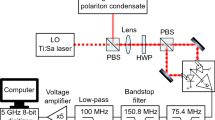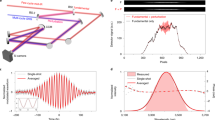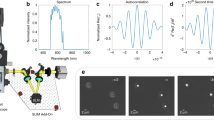Abstract
Ghost imaging is a novel technique that produces the image of an object by correlating the intensity of two light beams, neither of which independently carries information about the shape of the object1,2. Ghost imaging has opened up new perspectives to obtain highly resolved images3, even in the presence of noise and turbulence4. Here, by exploiting the duality between light propagation in space and time5, we demonstrate the temporal analogue of ghost imaging. We use a conventional fast detector that does not see the temporal ‘object’ to be characterized and a slow integrating ‘bucket’ detector that does see the object but without resolving its temporal structure. Our experiments achieve temporal resolution at the picosecond level and are insensitive to the temporal distortion that may occur after the object. The approach is scalable, can be integrated on-chip, and offers great promise for dynamic imaging of ultrafast waveforms.
This is a preview of subscription content, access via your institution
Access options
Subscribe to this journal
Receive 12 print issues and online access
$209.00 per year
only $17.42 per issue
Buy this article
- Purchase on Springer Link
- Instant access to full article PDF
Prices may be subject to local taxes which are calculated during checkout





Similar content being viewed by others
References
Erkmen, B. I. & Shapiro, J. H. Ghost imaging: from quantum to classical to computational. Adv. Opt. Photon. 2, 405–450 (2010).
Bennink, R. S., Bentley, S. J., Boyd, R. W. & Howell, J. C. Quantum and classical coincidence imaging. Phys. Rev. Lett. 92, 033601 (2004).
Ferri, F. et al. High-resolution ghost image and ghost diffraction experiments with thermal light. Phys. Rev. Lett. 94, 183602 (2005).
Meyers, R. E., Deacon, K. S. & Shih, Y. Turbulence-free ghost imaging. Appl. Phys. Lett. 98, 111115 (2011).
Salem, R., Foster, M. A. & Gaeta, A. L. Application of space–time duality to ultrahigh-speed optical signal processing. Adv. Opt. Photon. 5, 274–317 (2013).
Klyshko, D. N. A simple method of preparing pure states of an optical field, of implementing the Einstein–Podolsky–Rosen experiment, and of demonstrating the complementarity principle. Sov. Phys. Usp. 31, 74–85 (1988).
Klyshko, D. N. Combine EPR and two-slit experiments: interference of advanced waves. Phys. Lett. A 132, 299–304 (1988).
Pittman, T. B., Shih, Y. H., Strekalov, D. V. & Sergienko, A. V. Optical imaging by means of two-photon quantum entanglement. Phys. Rev. A 52, R3429 (1995).
Abouraddy, A. F., Saleh, B. E. A., Sergienko, A. V. & Teich, M. C. Role of entanglement in two-photon imaging. Phys. Rev. Lett. 87, 123602 (2001).
Bennink, R. S., Bentley, S. J. & Boyd, R. W. ‘Two-photon’ coincidence imaging with a classical source. Phys. Rev. Lett. 89, 113601 (2002).
Scarcelli, G., Berardi, V. & Shih, Y. Can two-photon correlation of chaotic light be considered as correlation of intensity fluctuations? Phys. Rev. Lett. 96, 063602 (2006).
Meyers, R., Deacon, K. S. & Shih, Y. Ghost-imaging experiment by measuring reflected photons. Phys. Rev. A 77, 041801 (2008).
Shirai, T., Setälä, T. & Friberg, A. T. Ghost imaging of phase objects with classical incoherent light. Phys. Rev. A 84, 041801 (2011).
Zhang, C., Guo, S., Cao, J., Guan, J. & Gao, F. Object reconstitution using pseudo-inverse for ghost imaging. Opt. Express 22, 30063–30073 (2014).
Karmakar, S., Meyers, R. & Shih, Y. Ghost imaging experiment with sunlight compared to laboratory experiment with thermal light. Proc. SPIE 8518, 851805 (2012).
Sun, B. et al. 3D computational imaging with single-pixel detectors. Science 330, 844–847 (2015).
Tournois, P. Analogie optique de la compression d'impulsions. C. R. Acad. Sci. III 258, 3839 (1964).
Kolner, B. H. & Nazarathy, M. Temporal imaging with a time lens. Opt. Lett. 14, 630–632 (1989).
Kolner, B. H. Space–time duality and the theory of temporal imaging. IEEE J. Quantum Electron. 30, 1951–1963 (1994).
Foster, M. A. et al. Silicon-chip-based ultrafast optical oscilloscope. Nature 456, 81–84 (2008).
Schröder, J. et al. Aberration-free ultra-fast optical oscilloscope using a four-wave mixing based time-lens. Opt. Commun. 283, 2611–2614 (2010).
Solli, D. R., Herink, G., Jalali, B. & Ropers, C. Fluctuations and correlations in modulation instability. Nature Photon. 6, 463–468 (2012).
Fridman, M., Farsi, A., Okawachi, Y. & Gaeta, A. L. Demonstration of temporal cloaking. Nature 481, 62–65 (2012).
Shirai, T., Setälä, T. & Friberg, A. T. Temporal ghost imaging with classical non-stationary pulsed light. J. Opt. Soc. Am. B 27, 2549–2555 (2010).
Chen, Z., Li, H., Li, Y., Shi, J. & Zeng, G. Temporal ghost imaging with a chaotic laser. Opt. Eng. 52, 076103 (2013).
Soper, H. E. On the probable error of the correlation coefficient to a second approximation waveforms. Biometrika 9, 91–115 (1913).
Salem, R. et al. Optical time lens based on four-wave mixing on a silicon chip. Opt. Lett. 33, 1047–1049 (2008).
Acknowledgements
G.G. and A.T.F. acknowledge support from the Academy of Finland (projects 267576 and 268480). J.M.D. acknowledges support from ERC project MULTIWAVE. The Optoelectronics Research Centre, Tampere University of Technology is also thanked for the loan of the pulse pattern generator.
Author information
Authors and Affiliations
Contributions
G.G. and A.T.F. conceived the original idea. P.R. and M.B. constructed the experimental set-up and conducted all the experiments. G.G. designed the experiments and supervised the project. P.R., M.B., J.M.D. and G.G. performed the data analysis. All authors discussed the results and contributed to writing the manuscript.
Corresponding author
Ethics declarations
Competing interests
The authors declare no competing financial interests.
Supplementary information
Supplementary information
Supplementary Movie 1 (MOV 832 kb)
Rights and permissions
About this article
Cite this article
Ryczkowski, P., Barbier, M., Friberg, A. et al. Ghost imaging in the time domain. Nature Photon 10, 167–170 (2016). https://doi.org/10.1038/nphoton.2015.274
Received:
Accepted:
Published:
Issue Date:
DOI: https://doi.org/10.1038/nphoton.2015.274



